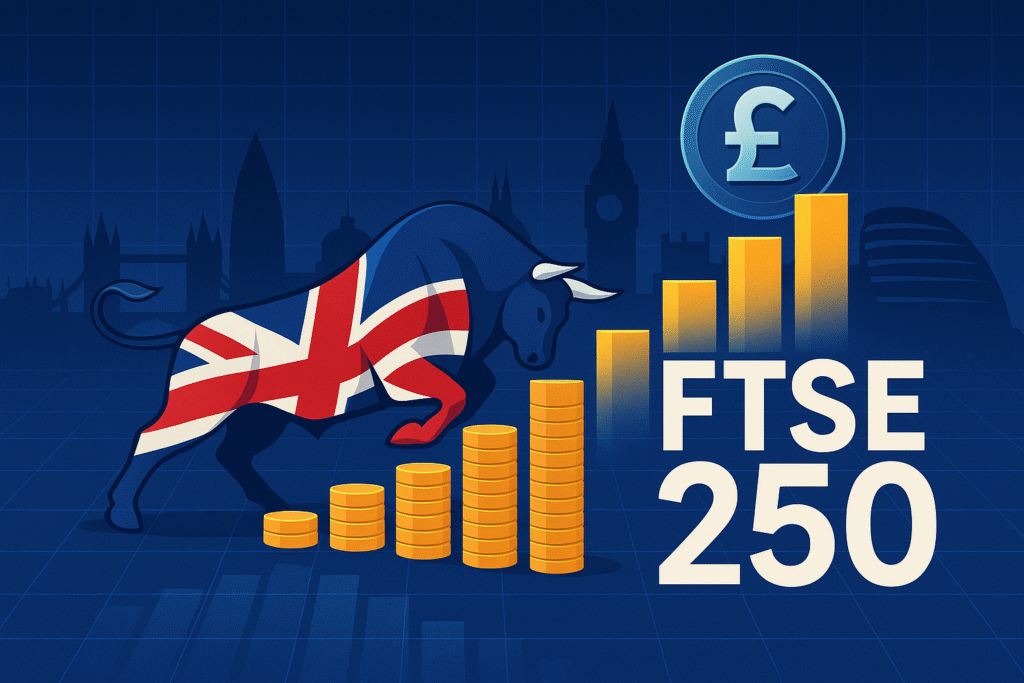FTSE 250, a mid-cap benchmark that tracks the 250 companies ranked just below the FTSE 100 on the London Stock Exchange, thereby captures the heartbeat of UK-centric growth stories, niche industrials, and fast-rising consumer brands. Consequently, the FTSE 250 has become an indispensable lens for investors who want a purer read on Britain’s domestic economy than the globally tilted large-cap indices can offer.

1. Snapshot (May 2025)
| Metric | Value | Transition Note |
|---|---|---|
| Index Level | 20 140 | To begin with, trading near record highs. |
| Free-Float Market Cap | £450 billion | Meanwhile, depth rivals many regional blue-chip indices. |
| Dividend Yield | 3.0 % | Thus, income sits between FTSE 100 and FTSE SmallCap levels. |
| Launch Year | 1992 | Accordingly, three decades of history aid cycle study. |
| Currency | Pound sterling | Therefore, sterling moves feed directly into returns. |
Constituents move in and out at each quarterly review; for example, companies that graduate to the FTSE 100 or slip into the FTSE SmallCap leave the FTSE 250—thereby keeping the basket fresh.
2. How the FTSE 250 Is Built
| Rule | Detail | Transition Note |
|---|---|---|
| Constituent Rank | 101st–350th by free-float market value on the LSE | First and foremost, size defines the universe. |
| Weighting | Free-float market-cap; no formal single-stock cap, but float limits curb insiders | Consequently, founder dominance is muted. |
| Review Schedule | First Wednesday of Mar, Jun, Sep, Dec | Moreover, changes reflect shifting market dynamics. |
| Liquidity Screen | Must meet median daily volume ≥ 0.05 % of shares | Hence, thinly traded names stay out. |
Recent promotions illustrate the pathway: Darktrace and CAB Payments jumped from SmallCap, whereas Diploma ascended to the FTSE 100. Thus, mobility within the FTSE hierarchy remains brisk.
3. Sector Breakdown (April 2025)
| Sector | Weight | Transition Note |
|---|---|---|
| Industrials | 22 % | Chiefly, niche engineering drives exports. |
| Financials (ex-banks) | 17 % | Meanwhile, insurers and asset managers add cash flow. |
| Consumer Discretionary | 15 % | Additionally, retailers benefit from resilient spending. |
| Health Care | 11 % | Likewise, mid-cap pharma offers innovation optionality. |
| Real Estate | 9 % | Thus, property cycles matter. |
| Materials | 8 % | Furthermore, specialty miners hedge inflation. |
| Others | 18 % | Collectively, tech, utilities, and telecoms round out exposure. |
Because domestic sales account for ≈ 55 % of revenue—much higher than the FTSE 100—the FTSE 250 provides a truer pulse on UK demand.
4. Recent Performance
| Year | Total Return (GBP) | Driver | Transition Note |
|---|---|---|---|
| 2022 | –17.0 % | Rate hikes, UK GDP fears | Initially, macro headwinds bit hard. |
| 2023 | +9.4 % | Services rebound, weak pound | Subsequently, currency tailwinds lifted exporters. |
| 2024 | +12.1 % | M&A bids, resilient consumer | Moreover, takeover premiums fueled gains. |
| YTD 2025 | +6.2 % | AI outsourcing plays, housing pickup | So far, tech-enabled services shine. |
Volatility averages 19 %—therefore higher than the blue-chip FTSE 100, reflecting smaller-cap beta.
5. Why Investors Track the FTSE 250
- Domestic Growth Gauge. Revenues linked to UK housing, retail, and services—hence providing a cleaner macro signal.
- M&A Target Pool. Private-equity and overseas buyers hunt mid-caps; consequently, takeover premiums boost returns.
- Diversification. Adds UK-centric flavour, thereby balancing the global earnings bias of the FTSE 100.
- ETF & Derivatives Access. Products such as MIDD (ETF) and ICE FTSE 250 futures grant liquid exposure, thus easing tactical trades.
6. Strengths & Caveats
| Strengths | Caveats |
|---|---|
| Quarterly rebalancing keeps the basket dynamic. | However, higher volatility and occasional liquidity gaps persist versus FTSE 100. |
| Lower commodity/energy weight reduces cyclicality. | Concentrated domestic exposure heightens Brexit and fiscal sensitivity. |
| Strong takeover-premium history. | Float limits can under-represent founder-led growth names. |
7. Themes to Watch
- AI-Enabled Services. Outsourcers and consultancies winning cloud contracts could continue to power the FTSE 250 tech cohort.
- UK Housing Revival. Rate cuts projected for Q4 2025 may lift house-builders and building-materials firms.
- Green Transition. Mid-cap renewables suppliers could, in turn, enter the FTSE 250 after pipeline IPOs.
- Sterling Path. A stronger pound would aid importers yet weigh on exporters’ translated earnings.
Key Takeaways
The FTSE 250 slots neatly between blue-chips and small-caps, reflecting UK-centric growth alongside global niche leaders. As of May 2025, it yields 3 %, trades near record highs, and therefore offers a live barometer for Britain’s domestic economy. Ultimately, investors tap the FTSE 250 for diversification, takeover optionality, and tactical plays on UK monetary and fiscal trends.